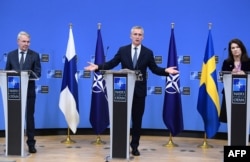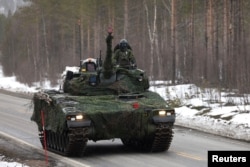Membership in NATO for Finland and Sweden now look less like questions of "if" than "when." But the next few weeks will be crucial for decision-makers in both Helsinki and Stockholm.
Here's what you need to know as the transatlantic military alliance inches closer to increasing its membership from 30 to 32 after Russia’s full-scale invasion of Ukraine 10 weeks ago.
What dates are important?
On May 11, the Finnish parliament’s foreign affairs committee is expected to start drafting a short report for the plenary on the numerous hearings it has held since Helsinki completed a security white paper in April. That white paper contained no concrete recommendation on joining NATO but described the changing security environment in Europe since February.
Two days later, on May 13, Stockholm is expected to publish a Swedish security report in its effort to catch up with its Nordic neighbor to the east.
However, the more crucial -- but so far tentative -- dates to look out for are May 14-15.
On May 14, Finnish Prime Minister Sanna Marin's Social Democratic Party, the largest group in parliament, is expected to establish its position on NATO membership. Swedish Prime Minister Magdalena Andersson's Social Democrats should do the same a day later. Both leaders are believed to prefer membership for their respective countries, but both of their parties have, at least historically, been lukewarm on joining NATO.
Then there's May 17-18, when Finland’s largely ceremonial but highly influential President Sauli Niinisto travels to Sweden on an official visit. He is also believed to favor NATO membership and has noted that “Finland’s course will be clear by the time of the visit." So don’t rule out some sort of official joint proclamation in Stockholm during the visit.
Then there is the NATO summit in Madrid on June 28-30. NATO officials have indicated that the accession protocols for Finland and Sweden could be signed at that time if the formal applications landed on NATO Secretary-General Jens Stoltenberg’s desk by the end of May.
Can NATO really accept Finland and Sweden so quickly?
Yes, it seems entirely plausible, especially since there is no indication that any of the 30 allies oppose Swedish or Finnish membership.
Their armies are already mostly interoperable with NATO, thanks in part to their membership in NATO’s Partnership for Peace (PfP) since 1994 and Enhanced Opportunity Partners (EOP) 20 years later -- two structures that ensure smoother cooperation with the military organization. They regularly conduct exercises with NATO, have worked under NATO command in the Western Balkans and Afghanistan, as well as since Russia's invasion began on February 24, and Finnish ministers and diplomats have attended most NATO meetings.
And then there is the added value for NATO.
Finland, with universal male conscription, could boast 280,000 troops and 900,000 trained reserves in wartime -- potentially making it one of NATO's biggest forces. With major weapons procurement under way for naval assets and new F-35s, it will meet NATO’s defense-spending target of 2 percent of GDP already this year -- something only around one-third of current alliance members have achieved.
Sweden has announced that it will boost military spending and reach the 2 percent target within a few years, and it is likely that the size of its armed forces, currently around 24,000 men and women, will increase considerably. And do not dismiss the Swedish arms industry, which, with a reported turnover of 3.5 billion euros ($3.7 billion) a year, churns out modern cannons, anti-aircraft guns, and its crown jewel: the JAS fighter aircraft.
One NATO official, speaking on condition of anonymity, also highlighted to RFE/RL the attraction of having Finnish and Swedish technology giants Nokia and Ericsson "in the NATO orbit as well."
What about the ratification process?
This normally takes about a year, as 30 national parliaments must debate and vote on the issue -- frequently after first debating it in committee. But high-ranking politicians and officials from both countries have been busy touring various NATO capitals in recent months to request considerably accelerated processes.
A key event here is the NATO Parliamentary Assembly, whose spring session is planned for Vilnius on May 27-30. That body, which brings together deputies from throughout the alliance, is scheduled to meet and listen carefully to the Finnish and Swedish delegations in the Lithuanian capital.
So don’t be surprised if the ratification process is already over by late summer or early autumn.
Would Finland and Sweden get security guarantees in the interim?
Possibly the most pressing issue is one that prime ministers Andersson and Marin have been exploring keenly in their talks with other leaders. It is clearly stated that NATO’s Article 5, its mutual-defense clause, only covers alliance members. That has left Sweden and, more notably, Finland, with its 1,300-kilometer border with Russia, nervous as they ponder membership and await what are expected to be months of formalities among NATO and its member states.
Both Swedish and Finnish officials have stressed that they aren’t actually seeking "guarantees," which would be legally binding and therefore implausible, but rather "security assurances or support."
No country has explicitly said how they would protect Finland or Sweden against potential attack. But a NATO official told RFE/RL that to "invite a country [to join] and then just passively stay on the sidelines if that country came under fire during the interim period" would hurt the alliance's credibility. A potential solution, the source suggested, is an increased NATO presence in the Nordic region in the coming months through military exercises.
Can we rule out a referendum on NATO membership in either country?
In all likelihood, yes. Both countries held referendums in 1994, when their publics voted in favor of EU membership. But this time there appears to be a need for speed.
One Finnish diplomat acknowledged that if a referendum were held with all the necessary preparation and prolonged public debate, "we would expose our system to outside interference." A recent Swedish poll suggests over 60 percent of respondents oppose a plebiscite, and the Swedish prime minister has indicated that she wants the question “sorted” well before parliamentary elections in late September.
With the ruling Social Democrats in both countries expected to favor membership, there are likely to be large pro-NATO parliamentary majorities in both places, and recent surveys suggest around two-thirds of Finns and Swedes support NATO membership.
Will Russia try to interfere in any way?
Russia has expressed public objections and hinted at "military and political consequences," including nuclear deployments, if Sweden or Finland joins NATO, and there has been much speculation about various hybrid threats. But a Western military official with insight into the security environment in northern Europe says there have been no active measures from Russia so far and that there is no imminent military threat against Finland or Sweden, despite a few violations of the territorial integrity of both countries in recent weeks, as well as denial-of-service attacks on Swedish and Finnish government websites. Such incidents, the source noted, have occurred in more peaceful times as well.
The source also pointed out that Russia’s capabilities on its northeastern border with Finland are "rather limited, as most units have sent forces down to Ukraine, where they have suffered severe casualties.” The official added that it would “take years for Russia to undertake a bigger military buildup close to the Finnish borders, as most efforts now are focused on the war in the eastern part of Ukraine.”
The one threat that seems possible, the source said, is an increase in the number of nuclear missiles that end up being stationed in the Baltic Sea region, notably in Kaliningrad but also on the Kola Peninsula.











